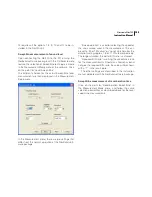
168
Chapter 25
Speech Intelligibility by STIPA
Measure the STI-value as described above. Place
the cursor above the field “Off” in “Noise correction:
Off”, and press
INC
or
DEC
button to toggle the value
to “On”. The results will be recalculated to account for
the specified background noise.
The result is corrected for a stored background
noise spectrum. If you want to edit the values, move
the field cursor to the field “NCorr:” and press
ENTER
.
The field cursor is automatically placed at the lowest
octave-band 125 Hz. Write in the required level for
each octave by using the numeric keyboard. An “#E”
at the bottom of the display indicates numeric key-
board (second function) and that each entry has to
terminated by pressing
ENTER
. Move the cursor field
to the next frequency by using the cursor buttons be-
low the display and enter the corresponding level. For
terminating the edition and returning to the main menu,
press an additional
ENTER
. The noise corrected val-
ues are automatically recalculated.
An alternative to keying in the levels for the background
noise is to use values from a previously stored meas-
urement. The measured levels must have been made
in 1/1- or 1/3-octave bands. Press
RECALL
while the
table for the background noise is displayed. Select the
requested file from stored results and press
ENTER
to
read in the data. Values measured in 1/3-octave bands
are recalculated to 1/1-octave values.
When stored, a file number is shown
in the upper line, is automatically assigned
to the measurement
Edition of the background noise level
ENTER
Correcting for background and occupancy
noise
The STIPA method considers the effect of the actual
background noise when the intelligibility is assessed.
However, in some cases we want to find out what the
intelligibility would have been if we had a certain back-
ground noise. A typical application will be to assess
the intelligibility in an auditorium with audience when
the auditorium was measured without. For such ap-
plications, the optional noise correction may be used.
NOTE!
You may obtain the averaged noise
level from different measurement positions
by making a normal measurement in the
first position, then move to the next and
press
CONT
for prolonging the measure-
ment time!
Summary of Contents for nor140
Page 4: ......
Page 16: ......
Page 17: ...nor140 SOUND ANALYSER ...
Page 18: ......
Page 212: ...194 ...
Page 218: ......






























